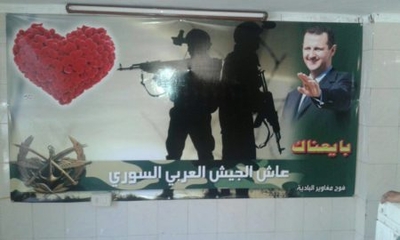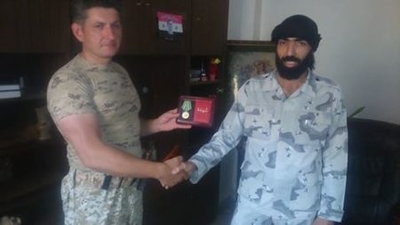
Emblem of Fawj Maghawir al-Badiya, with the militia's name itself inscribed on the bottom. On top: "Military Intelligence Branch" (indicating the affiliation of the group). In the centre is the emblem of the Syrian Arab Republic, as well as the Syrian and Ba'ath Party flags.
The regime's dependency on foreign and native militias to deal with manpower shortage issues and the decline of the regular army is well known. An immediate problem that arises with this phenomenon is a potential breakdown in order and control as militias take power on the ground into their own hands. A mechanism to try to minimize this problem is to have militias operate under some framework of the Syrian state. For example, some militias like the Homs-based Kata'ib al-Jabalawi(Jabalawi Battalions) and Leopards of Homs are affiliated with the al-Bustan Association of regime businessman Rami Makhlouf, who is also Bashar al-Assad's cousin.
Another option is to turn to the state's multiple intelligence agencies that can support and oversee militias. A prominent case-in-point is the Tiger Forces led by Suheil al-Hassan. Widely perceived to be an elite Syrian army unit, the Tiger Forces is actually a militia affiliated with the Air Intelligence (al-Mukhabarat al-Jawiya), which is unsurprising given Suheil al-Hassan's own career that began in air defence and then moved to Air Intelligence. Indeed, as Aron Lund notes, Suheil al-Hassan "does not seem to control a huge force, instead relying on local troops and a smaller entourage of personal loyalists from varied backgrounds."
Unlike the Tiger Forces, Fawj Maghawir al-Badiya ("The Desert Commandos Regiment") that is the subject of this profile is not affiliated with the Air Intelligence, but rather the Military Intelligence Branch (Shu'abat al-Mukhabarat al-Askariya). The group should also not be confused with the similar-sounding Fawj Maghawir al-Bahr ("Navy Seals/Navy Commandos Regiment"), which is closely linked to Suqur al-Sahara' ("The Desert Falcons")- something illustrated by joint participation in a number of recent operations. Indeed, the leader of Fawj Maghawir al-Bahr is one Aymenn Jaber, who is the brother of Suqur al-Sahara' leader Muhammad Jaber. It should also be noted that both groups were set up and provided training by the same person: Staff Brigadier Mohsen Sa'id Hussein, who was originally from the village of al-Sisiniya in Tartous governorate and killed in November 2014 in fighting around al-Sha'er field in Homs governorate. He notably played a military commander role in operations to push back the jihadist-led Latakia offensive in spring 2014, and in leading Suqur al-Sahara' operations in the Homs desert he gained the nickname "Lion of the Desert." He is also credited with the idea of setting up the Coastal Shield militia as well as being the reputed fonder of the Lions of the East (aka Tribal Army) militia composed of pro-regime Sha'itat tribesmen and other local recruits in Deir az-Zor province.
Fawj Maghawir al-Badiya appears to have at least one affiliate brand (namely, abrigade named for Sayyida Zainab). The militia is a more recent formation than Suqur al-Sahara' and Fawj Maghawir al-Bahr. According to a representative for the group interviewed in late July 2016, Fawj Maghawir al-Badiya was set up 9 months ago: that is, dating back from July 2016, which would put the beginnings of the militia in the autumn of 2015. The same representative affirmed that the group's most notable engagements so far include fighting in the Homs desert (e.g. Palmyra and Sha'er field) and the Aleppo battles. The former entails battles against the Islamic State, the latter battles against the rebels. Evidence for these engagements can be found in the open source realm. For example, earlier this month, a local 'martyr' from Aleppo was claimed to have been in the group's ranks and killed fighting in the Mashru' 1070 area to the southwest of the city as regime forces and allies tried to prevent the rebels from breaking the siege of eastern Aleppo. In a similar vein, see here for a sample post on fighting in the Sha'er area involving Fawj Maghawir al-Badiya.

Iyad Muhammad Aqil, from al-Marana in Tartous governorate. Reported in late April 2016 to have been killed fighting for Fawj Maghawir al-Badiya in Palmyra area.
Like other pro-Assad Syrian militias and Iraqi Shi'a militias, Fawj Maghawir al-Badiya has advertised recruitment through social media- in particular Facebook- by putting up posts offering connection for recruitment principally via phone numbers, though direct messaging of the Facebook pages can also be available as an avenue for inquiry. In fact, recruitment advertisement for Fawj Maghawir al-Badiya was reiterated as recently as 27 August 2016, offering a monthly salary of $200. Besides the monetary incentive, the militia also promises taswiyat al-wada' ("sorting out of affairs"). This reflects a wider trend of pro-Assad militias' attempts to compensate for manpower shortages caused by draft avoidance, particularly in offering an amnesty of some kind for draft-dodgers who sign up. As part of a recruitment expansion campaign, a page for the militia reported in early July 2016 that Fawj Maghawir al-Badiya's leader had ordered for the opening of offices in all the governorates for the purpose of recruitment.

A Fawj Maghawir al-Badiya office, reportedly located in the village of al-Aqrabiya in Homs governorate near the border with Lebanon, where a significant Shi'i population exists.

Closer view of one of the posters on the door, featuring the group's emblem and its alternative moniker (Kata'ib al-Sheikh Suleiman al-Shwakh), about which more below.

Fawj Maghawir al-Badiya poster: "We have pledged allegiance to you [in reference to Bashar al-Assad]. Long live the Syrian Arab Army."

Another Fawj Maghawir al-Badiya poster, with Hafez al-Assad on the left and Bashar al-Assad on the right. On left: "Peace on your soul." On right: "We are the descendants of your father."
In addition to recruitment offices, Fawj Maghawir al-Badiya has also claimed to open offices dealing with the affairs of "martyrs and wounded" (killed and wounded): that is, to provide care for the wounded and the relatives of those killed in fighting. This is a common administrative feature adopted by many armed factions including rebels and the Islamic State.

"Office to track the wounded and martyrs"- an office run by Fawj Maghawir al-Badiya, reportedly in al-Adawiya in Homs city.
Of particular interest is the leader of Fawj Maghawir al-Badiya, a man called Suleiman al-Shwakh (aka Abu Ali), from whose name derives another moniker for the militia: Kata'ib al-Sheikh Suleiman al-Shwakh ("Sheikh Suleiman al-Shwakh Battalions"), which appears in photos above from the group's office in al-Aqrabiya. Suleiman al-Shwakh is originally from Raqqa (as he himself confirmed to me in conversations this month), and he says that he still has some relatives living under the rule of the Islamic State there, but thinks most of the people in Raqqa are with Bashar al-Assad. This latter assertion is questionable, but it is certainly true that regime loyalists have existed in Raqqa during the course of the Syrian civil war, and appear to have made their presence known even after the city came under Islamic State rule by 2014. Suleiman al-Shwakh adds that he undertook army service, and traces Fawj Maghawir al-Badiya's founding slightly further back to a year ago.
For Suleiman al-Shwakh's role in the operations to retake Palmyra and some of the countryside villages from the Islamic State, the Russians bestowed an award on him. According to Fawj Maghawir al-Badiya, the award was bestowed per direction from the military command in Moscow and presented by a Russian general overseeing Syrian forces operating in Palmyra.

Suleiman al-Shwakh (right) being presented with his award.
So far, Fawj Maghawir al-Badiya remains a relatively minor formation in terms of casualty numbers: Suleiman al-Shwakh claimed to me that the group has 25 'martyrs.' However, the militia is an interesting case study of militias operating under the framework of the state's intelligence agencies. While this mechanism appears to give a greater degree of control for the regime over militias and thus give the impression of more law and order on the regime side as opposed to the rebels, it is certainly possible for the various intelligence agencies to use their militia affiliates to compete with each other for influence and power in the regime rump state.

